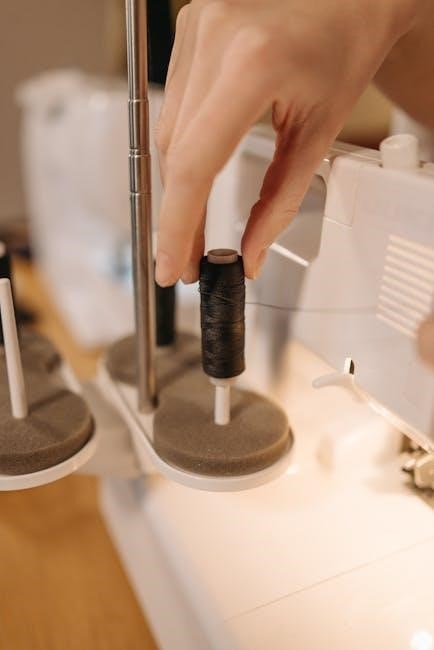The Kenmore Sewing Machine 158 Manual is an essential guide for optimal performance, offering detailed instructions, maintenance tips, and troubleshooting solutions for seamless sewing experiences.
1.1 Importance of the Manual for Optimal Machine Performance
The Kenmore Sewing Machine 158 Manual is crucial for ensuring optimal performance and longevity of the machine. It provides detailed instructions for setup, operation, and maintenance, helping users understand the machine’s features and functions. Regular maintenance, as outlined in the manual, prevents mechanical issues and ensures smooth sewing. Troubleshooting guides address common problems, saving time and effort. Whether you’re a beginner or an experienced sewer, the manual serves as an invaluable resource to maximize the machine’s potential and maintain its efficiency over time.
1.2 Brief Overview of the Kenmore Sewing Machine 158 Series
The Kenmore Sewing Machine 158 Series is a versatile line of machines designed for a wide range of sewing projects. Known for durability and reliability, these models offer advanced features like multiple stitch options, customizable settings, and specialized functions for both basic and intricate sewing tasks. The series includes various models, such as the 158.17560 and 158.1774, each tailored to meet different user needs. With a focus on ease of use and high performance, the 158 Series is ideal for sewers of all skill levels, providing tools to tackle everything from delicate fabrics to heavy-duty materials with precision and efficiency.
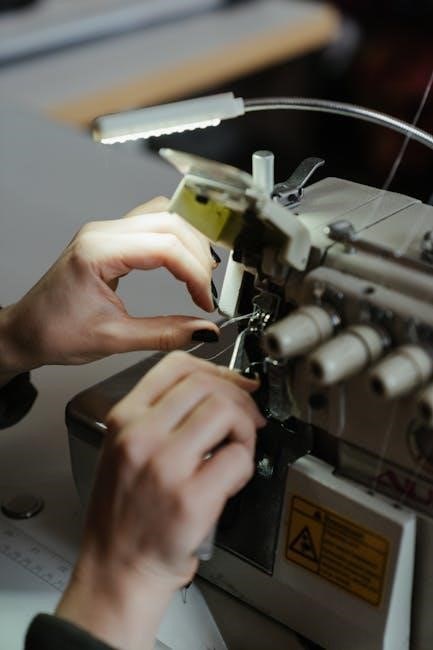
Key Features of the Kenmore Sewing Machine 158 Series
The Kenmore 158 Series boasts multiple stitch options, customizable settings, and specialized functions, ensuring versatility for various sewing projects, from delicate fabrics to heavy-duty materials.
2.1 Overview of Stitch Options and Customization
The Kenmore 158 Series offers a wide range of stitch options, including straight, zig-zag, and decorative patterns, allowing for precise customization. Users can adjust stitch length and width to suit various fabrics and projects. With the ability to select from multiple stitch types, sewists can achieve professional-looking results. Additional features like reverse stitching and specialized stitch modifiers enhance creativity and functionality. The machine’s versatility caters to both basic and complex sewing tasks, making it ideal for beginners and experienced sewists alike. Models such as the 158.17560 and 158.1774 provide extensive stitch libraries, ensuring adaptability for diverse sewing needs.
2.2 Specialized Functions for Versatile Sewing Projects
The Kenmore 158 Series boasts specialized functions designed to enhance versatility in sewing projects. Features like free-arm sewing allow for easy navigation around curves, while the drop feed mechanism is ideal for quilting and heavy fabrics. Automatic tension control ensures consistent stitching, reducing manual adjustments. Additionally, snap-on presser feet enable quick changes for various tasks, such as zipper installation or buttonholes. These functions cater to both delicate fabrics and robust materials, making the machine adaptable for embroidery, home décor, and garment construction. Models such as the 158.17560 and 158.1774 highlight these capabilities, ensuring users can tackle a wide range of sewing challenges with precision and ease.

Setting Up Your Kenmore Sewing Machine 158
Setting up your Kenmore 158 sewing machine involves unpacking, inspecting for damage, and familiarizing yourself with its components. Place it on a stable surface and ensure all accessories are accounted for before first use.
3.1 Unpacking and Initial Inspection of the Machine
Unpacking your Kenmore 158 sewing machine is an exciting first step. Carefully remove the machine from its box and inspect for any visible damage or dents. Check all included accessories, such as the power cord, foot pedal, and sewing feet, to ensure nothing is missing. Use the manual to identify and locate key components like the spool pins, bobbin winder, and stitch selectors. Before powering on, inspect the machine for loose parts or debris from shipping. Gently remove any protective packaging materials and ensure the surface is clean. This initial inspection ensures your machine is ready for safe and proper use.
3.2 Step-by-Step Guide to Threading the Machine
Threading your Kenmore 158 sewing machine correctly is crucial for smooth operation. Begin by turning the handwheel to raise the take-up lever to its highest position. Locate the spool pin and draw the thread through the guide, leaving a small loop. Gently pull the thread to seat it in the tension discs. Pass the thread through the take-up lever and then down to the needle; Insert the thread through the needle’s eye from front to back; Keep the thread taut but not overly tight to ensure proper tension. Refer to the manual’s diagrams for precise guidance and to avoid common threading mistakes.
3.3 Winding and Installing the Bobbin
Properly winding and installing the bobbin is essential for smooth stitching on your Kenmore 158 sewing machine. Start by placing the bobbin on the winder and threading the machine as instructed. Wind the bobbin evenly, ensuring the thread is tight but not overly so. Once full, cut the thread and remove the bobbin. To install, place the bobbin into the bobbin case, making sure it seats correctly. Gently pull the thread to ensure it’s secure. Some models require pulling off the top cover to access the bobbin area. Always check for lint or thread caught in the mechanism to prevent jamming. Proper installation ensures consistent stitches and prevents machine errors.
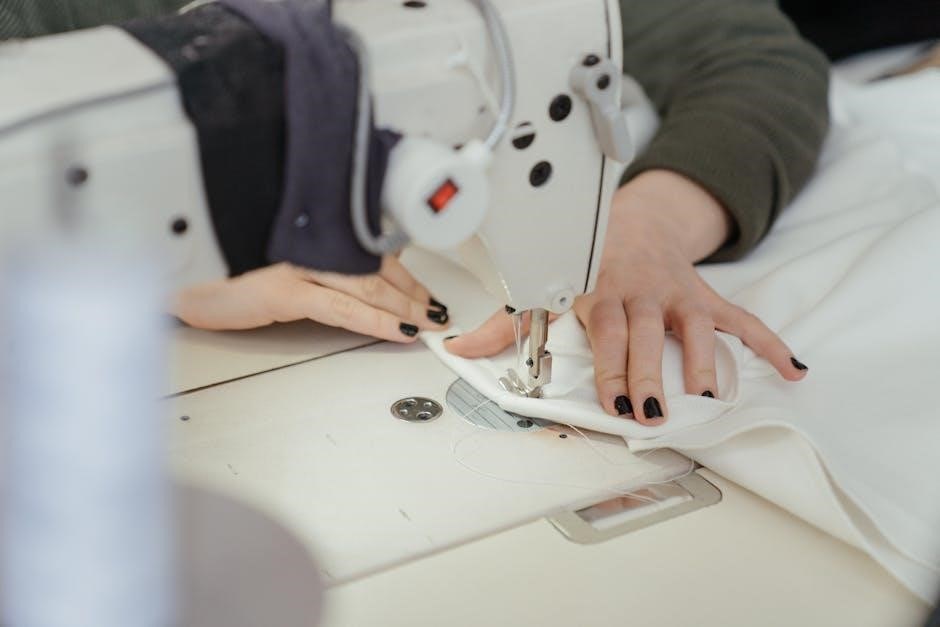
Maintenance and Care Tips
Regular cleaning, oiling, and checking parts ensure smooth operation and extend the life of your Kenmore 158 sewing machine. Follow manual guidelines for optimal care.
4.1 Cleaning the Machine Regularly
Regular cleaning is essential to maintain your Kenmore 158 sewing machine’s performance. Remove the top cover to inspect for thread or lint buildup. Use a soft brush or lint roller to clean dust and debris from the machine’s interior, paying attention to the bobbin area and feed dogs. Avoid harsh chemicals; instead, wipe surfaces with a dry, soft cloth. For stubborn lint, a small vacuum or compressed air can be used. Clean after each project to prevent dust accumulation. Regular maintenance ensures smooth operation and extends the machine’s lifespan. Always refer to the manual for specific cleaning instructions tailored to your model.
4.2 Oiling the Machine for Smooth Operation
Regular oiling is crucial for the Kenmore 158 sewing machine to ensure smooth operation and prevent mechanical wear. Use a high-quality sewing machine oil with an extendable spout for precise application. Apply a few drops to the oiling points, as indicated in the manual, typically around moving parts and gears. Avoid over-oiling, as it can attract dust and lint. Turn the handwheel gently to distribute the oil evenly. For models with removable covers, inspect and oil internal components periodically. Always refer to the manual for specific oiling instructions to maintain optimal performance and extend the machine’s lifespan.
4.3 Checking and Replacing Parts
Regularly inspect the Kenmore 158 sewing machine’s parts to ensure proper function. Check the bobbin area, feed dogs, and tension discs for lint or damage. Lubricate moving parts as needed. If parts like the needle, bobbin, or belts show wear, replace them promptly. Refer to the manual for specific instructions on replacing components. For complex parts, consult professional repair services. Genuine Kenmore replacement parts are available through Sears Parts Direct or authorized dealers. Regular inspections and timely replacements will maintain the machine’s efficiency and extend its lifespan. Always follow the manual’s guidance for compatible replacements to avoid operational issues.

Troubleshooting Common Issues
Identify and resolve common issues like thread breakage, tension problems, or machine noise by cleaning, oiling, or replacing worn parts. Consult the manual or seek professional help.
5.1 Resolving Thread Breakage and Tension Problems
Thread breakage and tension issues are common challenges. Start by inspecting the machine for lint or thread fragments. Clean thoroughly and ensure proper threading. Adjust the bobbin and top thread tensions according to the manual. Incorrect threading or uneven tension can cause breakage. Use high-quality thread and check the needle for damage; If issues persist, re-thread the machine with the power off and ensure the take-up lever is in the correct position. Regularly oiling the machine can also prevent friction-related problems. For persistent issues, consult the manual or seek professional assistance to avoid further damage.
5.2 Addressing Noise or Vibration Issues
Noise or vibration issues can disrupt sewing sessions. Start by tightening loose screws and ensuring all parts are properly aligned. Clean the machine to remove lint or debris that may cause friction. Check the balance of the machine and ensure it is placed on a stable surface. If the noise persists, inspect the bobbin area and ensure it is correctly installed. Lubricate moving parts with high-quality sewing machine oil as recommended. If vibrations continue, consider adjusting the machine’s placement or using anti-vibration pads. Persistent noise may indicate a need for professional servicing to prevent further damage.
5.3 Fixing Jammed Stitches or Bobbin Errors
If your Kenmore 158 sewing machine experiences jammed stitches or bobbin errors, start by turning off the machine and carefully removing the fabric. Gently cut any loose or tangled threads. Inspect the bobbin area for debris or misalignment. Remove the bobbin and clean any lint or dust using a soft brush. Reinstall the bobbin, ensuring it is seated correctly and the tension is balanced. If stitches remain uneven, rethread the machine, following the manual’s guidance. Test the machine on scrap fabric to ensure smooth operation. Persistent issues may require professional servicing to prevent further damage or mechanical failure.
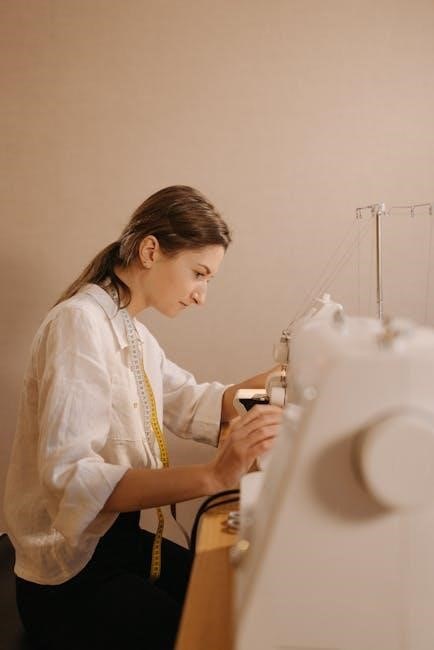
Advanced Sewing Techniques with the Kenmore 158
The Kenmore 158 offers advanced stitching options, enabling users to create intricate patterns and handle diverse fabrics with precision. Special attachments further enhance creative possibilities.
6.1 Mastering Zig-Zag and Straight Stitch Patterns
The Kenmore 158 excels in versatility with its zig-zag and straight stitch options, perfect for various sewing needs. Users can adjust stitch length and width for customization, while the reverse stitch lever ensures secure seams. The machine’s special stitch modifier enhances creativity, allowing for intricate patterns. Proper thread tension and regular maintenance, like cleaning and oiling, are key to consistent stitch quality. Practice and experimentation with different fabrics will help users master these stitches, unlocking endless possibilities for both basic repairs and complex designs. The manual provides clear guidance on optimizing these features for professional-grade results.
6.2 Sewing Delicate Fabrics and Heavy Materials
The Kenmore 158 is designed to handle both delicate fabrics and heavy materials with ease. For delicate fabrics, use a smaller needle and adjust stitch length to prevent tearing. For heavier materials like denim or canvas, switch to a larger needle and increase stitch length. The machine’s adjustable tension ensures even stitching on all fabric types. Using the right presser foot, such as the zig-zag or walking foot, enhances control. Proper thread selection and fabric preparation are key to achieving professional results. Regular maintenance, including cleaning and oiling, ensures smooth operation for any sewing project, from silk to leather.
6.3 Using Special Attachments for Decorative Stitches
The Kenmore 158 allows for creative sewing with various special attachments. The zig-zag foot is ideal for decorative stitching, while the embroidery hoop enables intricate patterns. Use the ruffler attachment for gathering fabric or creating pleats. To attach these, simply snap them onto the machine’s presser foot holder. Select the appropriate stitch and adjust settings like width and length for desired effects. Experiment with different fabrics and threads to enhance your designs. Always refer to the manual for specific attachment instructions and troubleshooting tips to ensure optimal performance and achieve professional-looking decorative stitches effortlessly.
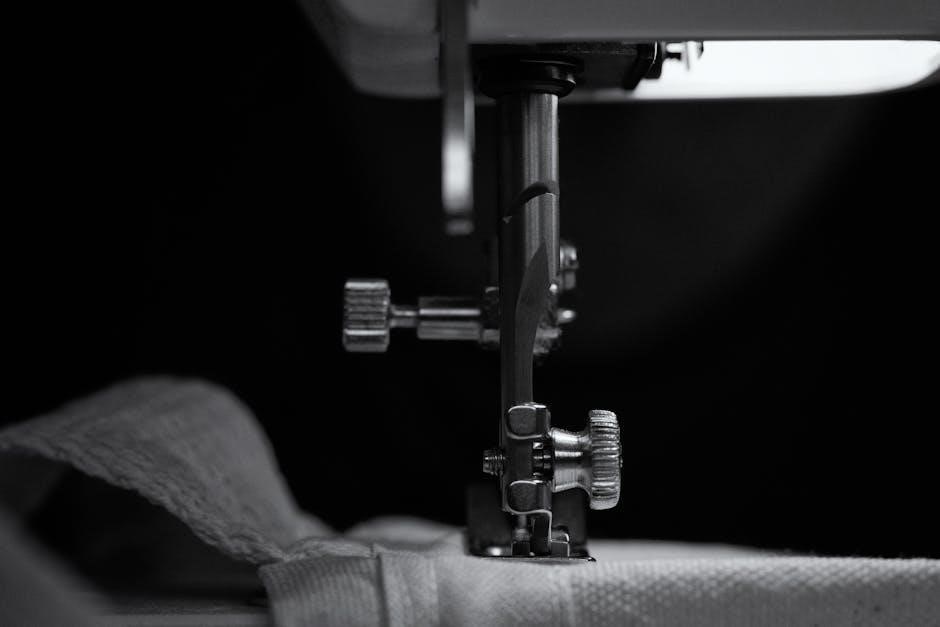
Model Variations and Compatibility
The Kenmore 158 series includes various models such as 158.120, 158.1358, and 158.1400, each offering distinct features for different sewing needs.
7.1 Overview of Different Kenmore 158 Models
The Kenmore 158 series encompasses a range of models, including 158.120, 158.1358, 158.1400, and 158.1690, each designed with unique features to cater to various sewing requirements. These models offer different stitch options, from basic straight and zig-zag stitches to more specialized decorative patterns, making them versatile for both beginners and experienced sewists. Some models include additional attachments for tasks like buttonholes or embroidery, while others focus on heavy-duty materials. The variety ensures users can choose the model that best fits their specific needs, whether for home use, crafting, or professional projects. This diversity makes the Kenmore 158 series a popular choice among sewing enthusiasts.
7.2 Compatibility of Accessories Across Models
Kenmore 158 models generally share compatibility with a range of accessories, including presser feet, bobbins, and stitch plates, allowing seamless integration across different versions. This universality simplifies the process for users with multiple machines or those upgrading, ensuring consistency and convenience. However, certain specialized attachments may vary between models, so it’s advisable to consult the manual or manufacturer guidelines to confirm compatibility before purchasing or using specific accessories. This flexibility enhances the overall versatility of the Kenmore 158 series, catering to diverse sewing needs while maintaining ease of use.

Downloading and Accessing the Manual
The Kenmore 158 manual is widely available as a PDF download from sources like Sears Parts Direct and other online repositories, ensuring easy access for users.
8.1 Sources for PDF Downloads of the Kenmore 158 Manual
The Kenmore 158 manual can be downloaded from various online sources, including Sears Parts Direct, which offers free PDF versions for multiple models like 158.17560 and 158.1774. Additionally, websites such as ManualsLib and Archive.org provide comprehensive access to these manuals, ensuring users can easily find and download the specific guide for their machine. These platforms often feature detailed instructions, diagrams, and troubleshooting tips, making them invaluable resources for both new and experienced sewists. Users can also find specific model variations, such as 158.14300 and 158.19800, ensuring compatibility and relevance for their particular sewing needs.
8.2 Printing and Binding Options for the Manual
For users who prefer a physical copy, the Kenmore 158 manual can be printed and professionally bound. Many online platforms, such as ManualsLib, offer printing services where manuals are coil-bound and printed in color when available. This ensures durability and ease of use. Additionally, users can print the PDF themselves and bind it using personal binders or sleeves. Sears Parts Direct and other websites provide clear, high-quality PDFs suitable for printing. Having a hard copy of the manual allows for quick reference while sewing, making it a practical option for both hobbyists and professionals who rely on the Kenmore 158 for their projects.

Additional Resources and Support
Online communities, forums, and Sears Parts Direct provide extensive support, including repair services, parts diagrams, and user discussions, ensuring comprehensive assistance for Kenmore 158 users.
9.1 Online Communities and Forums for Kenmore 158 Users
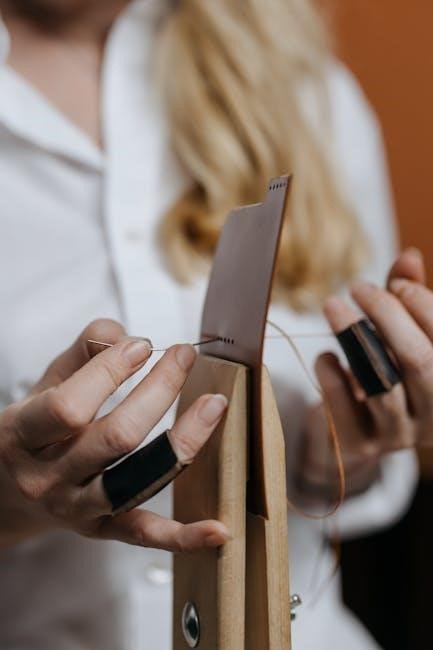
Online communities and forums dedicated to the Kenmore Sewing Machine 158 provide invaluable support and resources. Platforms like Facebook groups, Reddit forums, and specialized sewing communities offer spaces for users to share tips, solve problems, and showcase projects. These forums often include detailed troubleshooting guides, maintenance advice, and creative ideas for maximizing the machine’s potential. Many communities also host discussions where experienced users provide step-by-step solutions to common issues, such as thread breakage or bobbin errors. Additionally, these platforms frequently share links to user manuals, repair guides, and accessory recommendations, fostering a collaborative environment for Kenmore 158 enthusiasts to thrive and learn together.
9.2 Professional Repair Services for Maintenance
For comprehensive maintenance and repairs, professional services are available to ensure your Kenmore Sewing Machine 158 operates at its best. Authorized repair centers and skilled technicians offer expert diagnostics, cleaning, and part replacements. Sears Parts Direct provides genuine parts and detailed repair guides, while independent repair shops specialize in vintage models. These services extend the machine’s lifespan and restore performance. Regular professional maintenance can prevent issues like thread breakage and mechanical faults. Users can locate these services through official websites, forums, or local sewing communities, ensuring reliable and high-quality care for their Kenmore 158 sewing machine.

